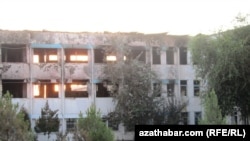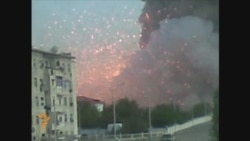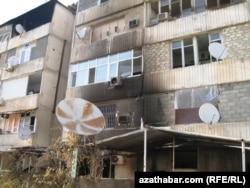
RFE/RL has written elsewhere about the disaster in Turkmenistan on July 7, when a series of massive explosions struck a military munitions depot in the town of Abadan, with a population 50,000, located less than 20 kilometers from Ashgabat, the capital.
The explosion killed dozens of people.
But that's not the only thing that's significant about the incident. The deadly explosions also mark the unprecedented emergence of citizen journalism in one of the world's most isolated countries.
Soon after the initial blast, the government shut down the Internet and telephone lines in Abadan. The town was evacuated and completely sealed off to all but emergency services.
Hours went by, but the state-controlled media still hadn't provided any radio or TV reports about the disaster. The only thing that emerged from the authorities was a brief statement:
This sort of thing is par for the course in Turkmenistan. Privately owned media do not exist in the country. TV and radio are tightly controlled by the state, which also closely monitors citizens' contacts with the outside world. Even a disaster like this would normally go unreported.
But this time, events took a different turn. One of the factors was the unprecedented activism of citizen journalists who reported the event to the outside world even as it was still unfolding -- in some cases risking their lives in the process. It's the first time in the history of Turkmenistan that anything like this has happened.
"Smoke reportedly started rising at the depot at 2 p.m. Turkmen time on July 7, and the first explosion took place at 4 p.m.," says Farit Tukhbatulin, head of the Vienna-based Turkmen Initiative for Human Rights, which runs a website with contributions from Turkmen citizen journalists. He says he first received word about two hours after that and posted it on the site. It was soon picked up by other media.
(RFE/RL's Turkmen Service first reported the blast at 5:43 p.m., based on reports from our correspondents and local sources.)
At around 7:30 p.m., EurasiaNet.org presented a more detailed version of the story. The following day, Radio Azatlyk, RFE/RL's Turkmen Service, made unique video footage of the event available (below).
But the reporting really got going with two pictures of the damaged buildings (posted later the same day) on the Turkmen version of the online social chat site teswirler.com.
"People: I just escaped from that place when the explosions started," wrote Jeronimo87, an apparent eyewitness to the explosion, in a comment posted on teswirler.com.
The post continued, "God keep us under his protection from what just happened. An artillery shell fell next to me. I barely escaped even with a car."
Another user, aylale, wrote: "One of the [shells] fell on my relatives' home. Thank God that they were able to escape in time."
Other bloggers described families who'd lost their homes sitting by the side of the road.
There were dozens of other comments posted on the website describing the event, and they've attracted dozens of responses.
This discussion was taking place while official Turkmen media were broadcasting their usual cheery songs and reports glorifying the president and all of his marvelous works. Some of the reporters got the word out from Abadan itself before the local communication networks were shut down. In the hours that followed, they kept the story going by moving to parts of the country where the Internet and mobile phone networks were still functioning.
"I've never seen reporting about an event in the country like this," says Tuhbatulin. "We've never seen anything like the activism of these citizen journalists in Turkmenistan." He calls their reporting "an information war" against government control, and says that "it was a clear victory for them."
By the next morning, despite the official blackout, news of the explosion was everywhere -- just not in the Turkmen media.
Only on July 10, three days after the event, did official media run a report saying that "a fire indeed started at a fireworks warehouse, but later spilled over to the arms depot, leading to the death of 15 people."
This is still fairly far removed from the unofficial version of the story reported by citizen journalists, who say the disaster actually started at the depot and led, in the end, to more than 200 deaths.
But by then it didn't matter what the government had to say. The citizen journalists had already made their point.
What remains to be seen is how the government will respond to its defeat. The authorities could try to adapt to the new reality and implement needed changes in media policy. Or they could try to tighten the screws even further.
-- Muhammad Tahir
The explosion killed dozens of people.
But that's not the only thing that's significant about the incident. The deadly explosions also mark the unprecedented emergence of citizen journalism in one of the world's most isolated countries.
Soon after the initial blast, the government shut down the Internet and telephone lines in Abadan. The town was evacuated and completely sealed off to all but emergency services.
Hours went by, but the state-controlled media still hadn't provided any radio or TV reports about the disaster. The only thing that emerged from the authorities was a brief statement:
"Today an emergency joint session of the Cabinet of Ministers and the State Security Council of Turkmenistan has discussed the situation regarding the ignition of pyrotechnical goods, intended for fireworks, stored at a special warehouse. The fire started as a result of the hot weather."
This sort of thing is par for the course in Turkmenistan. Privately owned media do not exist in the country. TV and radio are tightly controlled by the state, which also closely monitors citizens' contacts with the outside world. Even a disaster like this would normally go unreported.
But this time, events took a different turn. One of the factors was the unprecedented activism of citizen journalists who reported the event to the outside world even as it was still unfolding -- in some cases risking their lives in the process. It's the first time in the history of Turkmenistan that anything like this has happened.
"Smoke reportedly started rising at the depot at 2 p.m. Turkmen time on July 7, and the first explosion took place at 4 p.m.," says Farit Tukhbatulin, head of the Vienna-based Turkmen Initiative for Human Rights, which runs a website with contributions from Turkmen citizen journalists. He says he first received word about two hours after that and posted it on the site. It was soon picked up by other media.
(RFE/RL's Turkmen Service first reported the blast at 5:43 p.m., based on reports from our correspondents and local sources.)
At around 7:30 p.m., EurasiaNet.org presented a more detailed version of the story. The following day, Radio Azatlyk, RFE/RL's Turkmen Service, made unique video footage of the event available (below).
But the reporting really got going with two pictures of the damaged buildings (posted later the same day) on the Turkmen version of the online social chat site teswirler.com.
"People: I just escaped from that place when the explosions started," wrote Jeronimo87, an apparent eyewitness to the explosion, in a comment posted on teswirler.com.
The post continued, "God keep us under his protection from what just happened. An artillery shell fell next to me. I barely escaped even with a car."
Another user, aylale, wrote: "One of the [shells] fell on my relatives' home. Thank God that they were able to escape in time."
Other bloggers described families who'd lost their homes sitting by the side of the road.
There were dozens of other comments posted on the website describing the event, and they've attracted dozens of responses.
This discussion was taking place while official Turkmen media were broadcasting their usual cheery songs and reports glorifying the president and all of his marvelous works. Some of the reporters got the word out from Abadan itself before the local communication networks were shut down. In the hours that followed, they kept the story going by moving to parts of the country where the Internet and mobile phone networks were still functioning.
"I've never seen reporting about an event in the country like this," says Tuhbatulin. "We've never seen anything like the activism of these citizen journalists in Turkmenistan." He calls their reporting "an information war" against government control, and says that "it was a clear victory for them."
By the next morning, despite the official blackout, news of the explosion was everywhere -- just not in the Turkmen media.
Only on July 10, three days after the event, did official media run a report saying that "a fire indeed started at a fireworks warehouse, but later spilled over to the arms depot, leading to the death of 15 people."
This is still fairly far removed from the unofficial version of the story reported by citizen journalists, who say the disaster actually started at the depot and led, in the end, to more than 200 deaths.
But by then it didn't matter what the government had to say. The citizen journalists had already made their point.
What remains to be seen is how the government will respond to its defeat. The authorities could try to adapt to the new reality and implement needed changes in media policy. Or they could try to tighten the screws even further.
-- Muhammad Tahir











